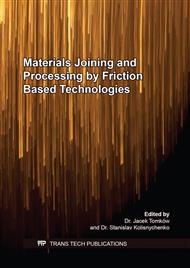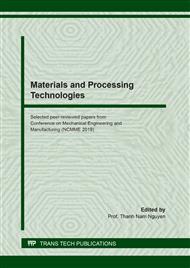p.33
p.51
p.59
p.67
p.73
p.79
p.85
p.97
p.103
Heat Transfer Simulations and Analysis of Joint Cross-Sectional Microstructure on Friction Stir Welding between Steel and Aluminium
Abstract:
This study presents conducted heat simulations and experimental jointing flat-plate of aluminum alloy 6061 and SUS 304. Temperature is simulated by the COMSOL software in three states: (1) Preheat the Friction Stir Welding (FSW) by TIG welding, (2) Thermal contact resistance between Aluminium and steel, and (3) The welding process using stiring friction is simulated. The simulations intended to predicting the temperature which is used for preheat and welding process to ensuring the required solid-state welding. The temperature is also determined and checked by a thermal imager comparing with simulation results. Besides, the results of tensile strength is carried out. The Box - Behnken method is used to identify the relationship between the welding parameters (rotation, speed and offset), temperature and tensile strength. The maximum tensile strength is 77% compared to the strength of aluminum alloy. The optimal set of parameters for the process is n = 676 rpm, v = 46 mm / min and x = 0.6 mm. The optimizing welding parameters to achieving good quality of welding process are described. SEM images to determine some properties of welding materials. This is also the basis for initial research to identify some defects in welding of two different materials (IMC thickness and interconnected pores) and the cause of these defects.
Info:
Periodical:
Pages:
85-95
Citation:
Online since:
September 2020
Price:
Сopyright:
© 2020 Trans Tech Publications Ltd. All Rights Reserved
Share:
Citation:



